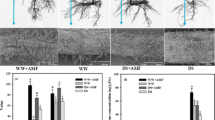Abstract
The progression of common root-rot lesions on subcrown internodes of Neepawa wheat and Bonanza barley plants inoculated 14, 26, 38 and 50 days after seeding was measured in growth chamber tests. Both in wheat and barley, lesion development was more rapid in older than in younger plants. Variables such as mean daily rates of linear progression of lesions, disease ratings, and proportion of plants becoming severely diseased were higher in older than in younger plants. The possible stress resulting from the removal of the crown roots on more rapid disease development in older than in younger plants is discussed.
Similar content being viewed by others
References
Broadfoot W C 1933 Studies on foot and root rot of wheat. I. Effect of age of the wheat plant upon the development of foot and root rot. Can. J. Res. 8, 483–491.
Butler F C 1961 Root and foot rot diseases of wheat. N. S. W. Dept. Agric. Sci. Bull. 77.
Christensen J J 1926 Physiologic specialization and parasitism ofHelminthosporium sativum. Minn. Agric. Expt. Stn. Tech. Bull. 37.
Harding H 1972 Reaction to common root rot of 14Triticum species and the incidence ofBipolaris sorokiniana andFusarium spp. in subcrown internode tissue. Can. J. Bot. 50, 1805–1810.
Ledingham R J 1961 Crop rotation and common root rot in wheat. Can. J. Plant Sci. 41, 479–486.
Ledingham R J, Sallans B J and Wenhardt A 1960 Influence of cultural practices on incidence of common root rot in wheat in Saskatchewan. Can. J. Plant Sci. 40, 310–316.
Simmonds P M and Sallans B J 1933 Further studies on amputations of wheat roots in relation to diseases of the root system. Sci. Agric. 13, 439–448.
Verma P R 1973 Studies of common root rot (Cochliobolus sativus) in Manitou wheat: epidemiology, loss assessment, inoculum density, and effects of phosphate. Ph. D. Thesis, Univ. of Saskatchewan, Saskatoon, Sask., 386 pp.
Verma P R 1982 Temporal progression of common root rot (Cochliobolus sativus) lesions on subcrown internodes of wheat and barley cultivars. Can. J. Plant Pathol. 4, 349–352.
Verma P R, Morrall R A A and Tinline R D 1974 The epidemiology of common root rot in Manitou wheat: disease progression during the growing season. Can. J. Bot. 52, 1757–1764.
Verma P R, Morrall R A A, Randell R L and Tinline R D 1975a The epidemiology of common root rot in Manitou wheat. III. Development of lesions on subcrown internodes and the effect of added phosphate. Can. J. Bot. 53, 2568–2580.
Verma P R, Tinline R D and Morrall R A A 1975b The epidemiology of common root rot in Manitou wheat. II. Effects of treatments, particularly phosphate fertilizer, on incidence and intensity of disease. Can. J. Bot. 53, 1230–1238.
Author information
Authors and Affiliations
Rights and permissions
About this article
Cite this article
Verma, P.R., Spurr, D.T. Effect of plant age on temporal progression of common root-rot (Cochliobolus sativus) lesions on subcrown internodes of wheat and barley. Plant Soil 101, 127–132 (1987). https://doi.org/10.1007/BF02371040
Received:
Revised:
Issue Date:
DOI: https://doi.org/10.1007/BF02371040




